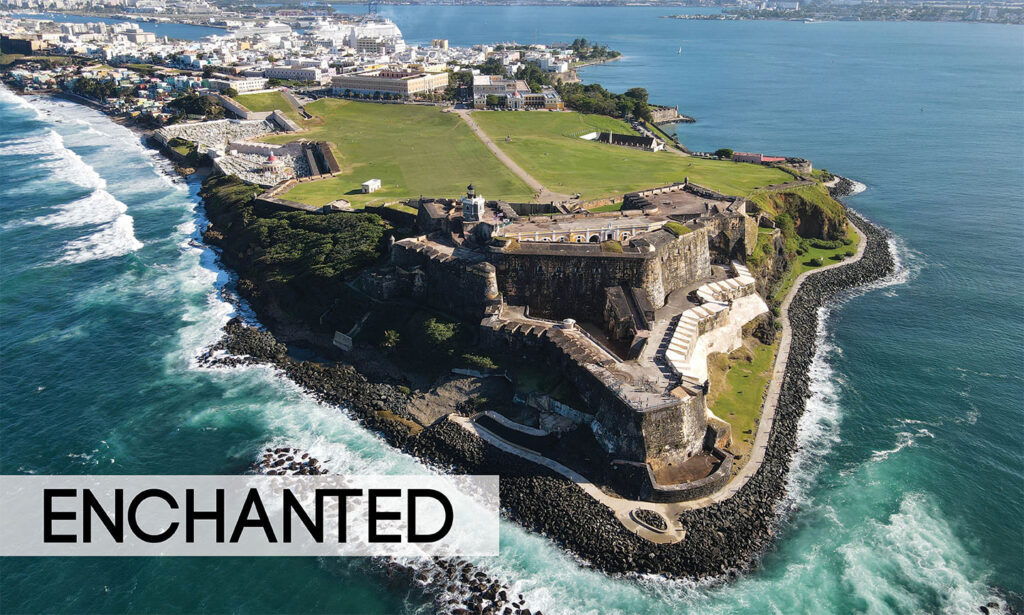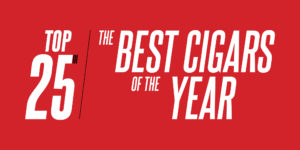Mention this small, mountainous island on the northeastern edge of the Caribbean Sea and you’ll likely hear a reference to reggaetón music, countless hall of fame major leaguers, or the world’s largest rum producer. Puerto Rico has been many things throughout its history and for about a year in the late 1990s, it was my home. So when the opportunity to return to the island to play its world-class golf courses and explore the cigar scene came up, I jumped at the chance.
The island’s magic captivates even the most jaded travelers. It’s not easy to pinpoint the source of her sorcery but having been a frequent visitor throughout my childhood, making it my home for a stint, and finally now returning post-hurricanes and pandemic, I may have an inside track.
Its beauty is in its chaos, its perpetual motion and constant change. At its core, the island is made up of juxtaposed forces. This rocky landmass, a shade smaller than the state of Connecticut, sits on the boundary between the Caribbean and North American tectonic plates. The island is composed of rock from the Jurassic period, dating back over 190 million years in the southwest corner, to far newer limestone rock visible all over the northeast region. This mashup of old and new, English and Spanish, American and Boricua, is a bewitching part of the island’s charm.
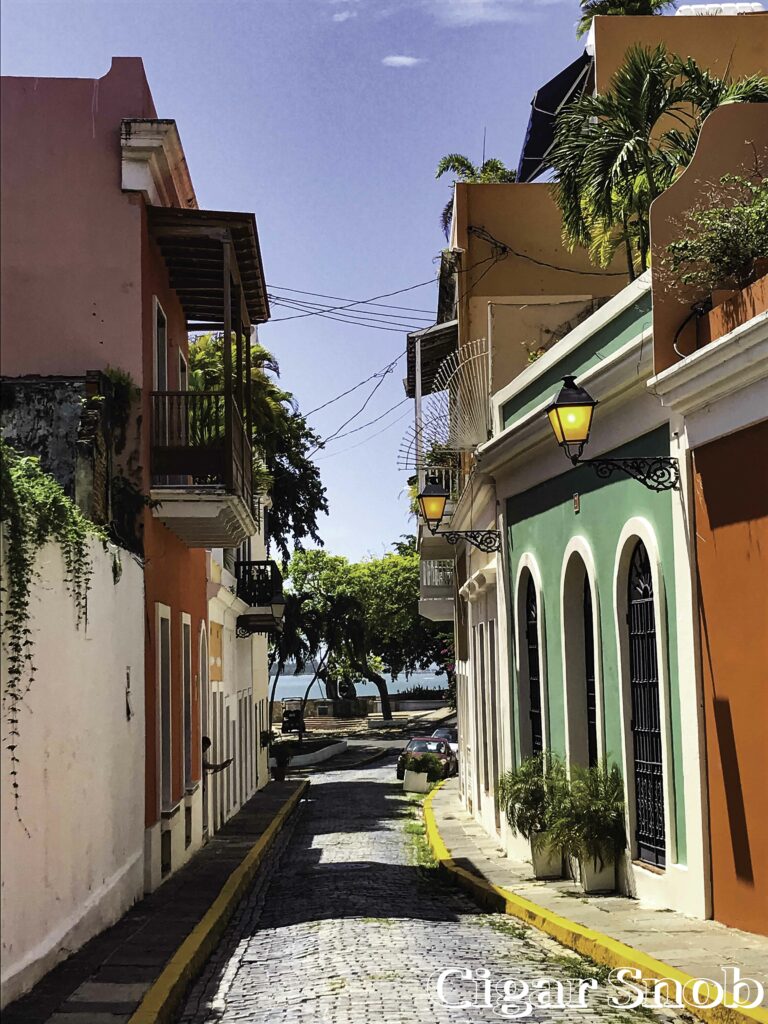
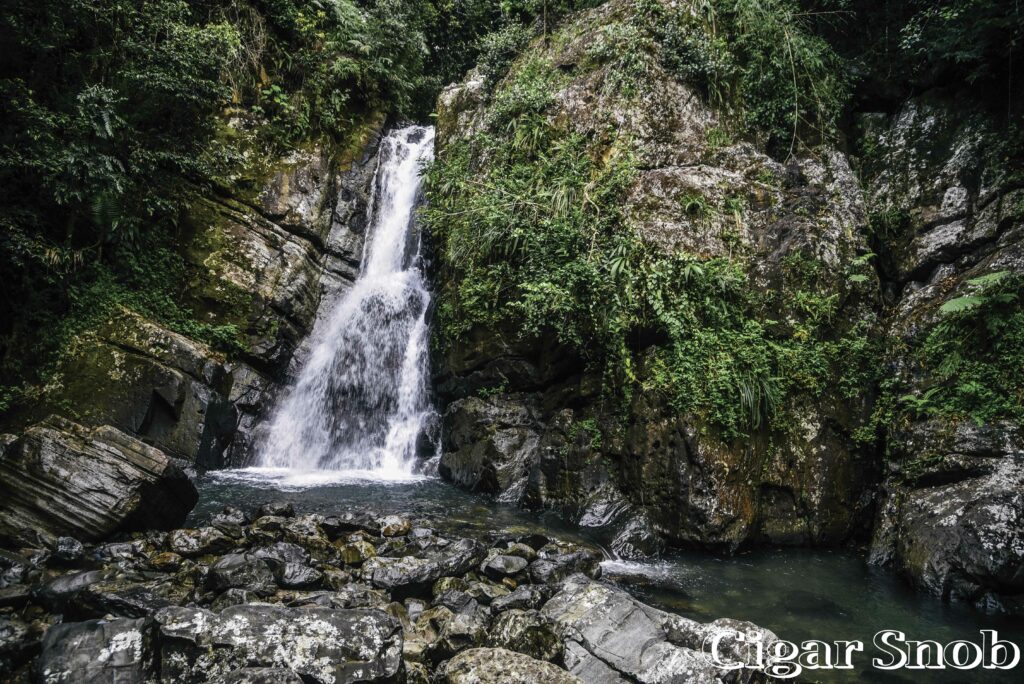
The Commonwealth of Puerto Rico is a territory of the United States, established by the Treaty of Paris of 1898 following the Spanish-American War. In the agreement, Spain granted Cuba its independence and ceded control of Puerto Rico, Guam, and the Philippines to the United States. Puerto Ricans are U.S. citizens although their representation in Congress is murky. The island has been forever divided between those who seek independence from the United States, those who want the island to gain full statehood, and those who like it just the way it is.
From a travel perspective, you’ll be hard-pressed to find a more convenient Caribbean destination – U.S. citizens with a valid state ID do not require a passport to enter the island. The U.S. dollar is the only currency in play, unless you plan to use [enter the crypto currency of the month here], in which case good luck with that. Your mobile phone service from the U.S. works seamlessly on the island. There are more than 120 daily nonstop flights from major U.S. cities into Luis Muñoz Marín International Airport in Carolina, just minutes from San Juan.
Driving in Puerto Rico feels at once familiar thanks to the U.S.-like system of roads and highways but becomes entirely foreign when you pull up to the gas station and find that the prices are in liters. Road signs contribute to that duality in that they have the same shape as their mainland U.S. counterparts but the words are in Spanish.
On the subject of language, the island’s charming contradictions and cultural mashups are perhaps most noticeable in the words and accents you hear on the street. Puerto Rico has two official languages, Spanish and English, with Spanish the primary language spoken by almost 95% of the island’s 3.2 million people, according to a 2020 U.S. Census. But long-term American influence on the island has birthed new words and phrases that make the Puerto Rican lexicon unique and wildly colorful. Originally English words like “pitch, hang, and park” become commonly used Spanglish words, “pichear, jangear, and parquear.”
In spite of or because of this, it’s hard to tell, English-speaking visitors find that communicating isn’t a big problem. Just about everyone you come across speaks enough English to help you find your way.
Old San Juan, the island’s cultural heartbeat, is like stepping back into the island’s Spanish past. Founded in 1521, the walled city successfully beat back a who’s-who of invaders, most notably Sir Francis Drake, thanks to its strategic fortifications: Castillo San Felipe del Morro, commonly known as “El Morro;” Castillo San Cristóbal; and the smaller Fort San Juan de la Cruz or “El Cañuelo.” The two bastions created a crossfire that guarded the entrance to San Juan Bay while San Cristóbal guarded the city from enemies approaching by land. It wasn’t until the U.S. bombardment of San Juan during the Spanish-American War (1898) that the fortifications showed any sign of weakness.
These landmarks along with the San Juan Gate make up the San Juan National Historic Site, a U.S. national park. Before it was recognized as a UNESCO World Heritage site in 1983, golf was played on the grounds of El Morro. A 1950s episode of the travelog “This World of Ours” promoting Puerto Rico travel stated, “The once mighty cannonading has vanished and today amid memories of fighting men and valorous death.” The narrator paused momentarily before dropping a bomb of his own: “You play golf.
This is certainly one of the world’s most interesting courses.” Thankfully this brilliant idea fell out of favor before my time; there’s no telling how many “would-be invaders” I would have repelled with errant tee shots.
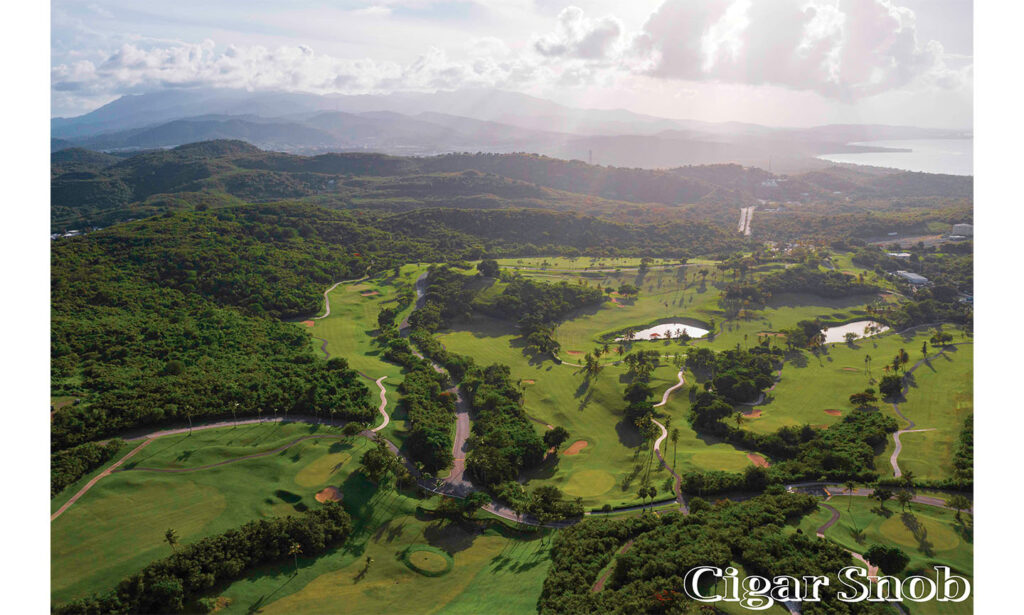
Golf in Puerto Rico
Golf was introduced by the Americans who managed the massive sugar cane mills, likely in the late 1920s. They played on temporary courses with sand greens. On its website, the Puerto Rico Golf Association confirms this notion. “In the beginning all courses on the island had sand greens, the local technique in Puerto Rico was to use beach-sand laced with coconut oil, then rolled more or less flat into a concave pie-shape.” Pitch mark repairs sound even more interesting. “After each match caddies meticulously repaired the dirt to pristine fresh, smoothing the surface with a burlap sack strapped to a pole, much as nowadays we rake and tidy sand bunkers.”
With the advent of World War II, the game’s growth accelerated, as military installations full of GIs needed recreational activities, and pretty soon all bases had some sort of golf component, including the aforementioned El Morro. After the war, however, golf course design and development has grown from knocking it around colonial fortifications and putting on sand greens to world-class designers laying out challenging tracks on stunning golf landscapes.
On this trip we played three incredible designs but there was a lot of meat left on the bone. Depending on whom you ask, Puerto Rico boasts somewhere between 18 and 30 courses from designers like Robert Trent Jones, Arthur Hills, Greg Norman, George and Tom Fazio, Tom Kite, and even Puerto Rico’s native son Chi Chi Rodriguez among others.
Chi Chi Rodriguez, born in 1935, is a former professional golfer known for his vibrant personality and distinctive style. He won eight PGA Tour events and achieved 22 victories on the Champions Tour, including eight senior major championships. Rodriguez’s flamboyant celebrations and famous “sword dance” endeared him to fans. Off the course, he founded the Chi Chi Rodriguez Youth Foundation in 1979, providing educational support and scholarships to at-risk youth. Rodriguez’s contributions to golf and philanthropy have left a lasting impact.
El Legado Golf Club in the southeast town of Guayama sits on a 285-acre valley presided over by the Cordillera Central mountains to the north and the ocean to the south. The par-72 layout is, to our knowledge, the only course designed by Chi Chi Rodriguez.
El Conquistador Resort
Built on a breathtaking tract atop a 300-foot oceanfront cliff on the island’s northeast tip, El Conquistador is a luxury boutique resort with an impressive set of amenities. As if the award-winning golf course, tennis facility, four pools, six sit-down dining options, oceanfront spa, and several bars weren’t enough, El Con features a water park complete with vertical drops, lazy rivers, and infinity pools. But perhaps the pièce de résistance that sets this resort apart from the competition is Palomino Island, the resort’s private, 100-acre getaway. Resort guests can access the island from 10 a.m. to 5 p.m. via a short water shuttle ride departing from the Marina Village.
Also inside the Marina Village is Ballyhoo, the resort’s waterfront bar and grill. The menu features a combination of classic Puerto Rican favorites like bacalaitos and asopao as well as elevated bar fare like the 16 oz. Delmonico steak with a rum demi-glaze and the double cut pork chop with citrus sauce.
INSIDER NOTE: I was informed semi-confidentially that a cigar bar is in the works on the property, so be on the lookout for that if you’re planning a visit.
The golf course is a roller coaster of a layout across dramatic elevation changes wedged between the Atlantic and the El Yunque rainforest. Tight fairways, blind approaches, and swirling winds make Arthur Hills’ design challenging for all levels. However, the course tops out at 6,746 yards from the tips, and the punishments on errant shots are not as devastating as they could be, making it a player-friendly layout – as it should be for a resort course. There are four tee positions: black (6,746 yards), gold (6,378 yards), silver (5,819 yards), and jade (4,939 yards).
Featured Holes:
The opener, a downhill, sharply banked fairway that doglegs way right and out of view, starts you off with an immediate gut check. The par-4 plays at 395 yards from the black and depending on the wind and confidence level, long hitters can catch a downslope off the high bank on the left side of the fairway and get it close. The nerves of that first, early morning tee shot, with very little time to warm up, made this hole particularly exciting for me.
The 15th, called Nido de Águila or Eagle’s Nest, is another one that will be seared in my memory. The 540-yard par-5 again boasts an elevated tee into a winding, narrow fairway 200 feet below you. Being a flatlander from Miami, watching the impressive hang time on a drive doesn’t get old for me. Slicing your driver into the mini-forest that lines the right-hand side would be a score-killer, so consider taking advantage of the downslope and playing this one safe with a 3-wood favoring the left half. Or do what you came to do and have a rip at the driver for the fun of it; you didn’t come all the way here to play safe golf!
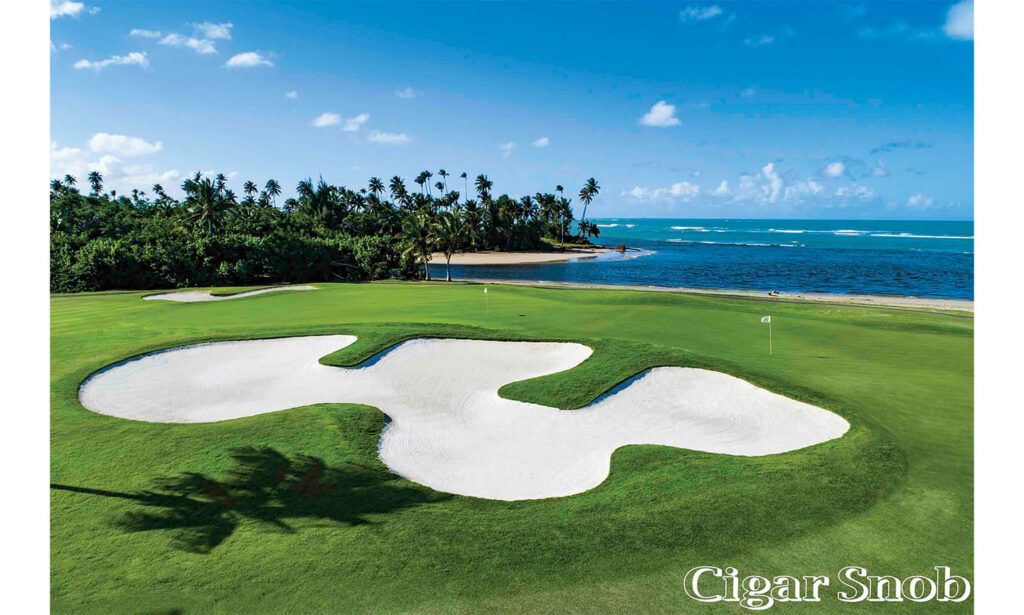
Hyatt Regency Grand Reserve
The home of the PGA Tour’s Puerto Rico Open is located in Río Grande, just east of San Juan. Hyatt Regency Grand Reserve is a 579-room, luxury resort offering standard rooms, suites, and deluxe 1,000+ sq ft villas with large terraces and sweeping ocean views. The resort offers five restaurants with diverse offerings from steak, to sushi, to Puerto Rican cuisine. The three main bars including The Sand Trap with its TopGolf Swing Suite serve up everything from prohibition style cocktails to classic piña coladas.
The resort doesn’t have a dedicated spot for cigar smokers but the open-air nature of the property made it easy to find spots where my smoke wasn’t bothering other guests – and at least during my visit, I was not asked to put out my cigar.
Grand Reserve Golf Club has hosted the Puerto Rico Open since 2008; the Tom Kite designed 27-hole facility breaks down into the Championship 18, where the likes of Jason Day, Tony Finau, and Viktor Hovland have made a name for themselves, and the nine-hole International course featuring more elevation changes. The Championship course stretches out to 7,551 yards from the back and its five tee positions offer plenty of options for every level of golfer.
During my visit, we played the Championship course and I found the constant views of El Yunque provided a Zen-like calm over the round while the wind ripping off the ocean on certain holes added a few strokes to the scorecard. The course was in exceptional condition with firm, fast greens that were often well guarded by bunkers and water. Once on the putting surface, however, they were among the truest rolling greens I have ever enjoyed. They’ve come a long way from sand and coconut oil to these world-class greens.
Featured Holes:
The 455-yard par-4 4th plays downwind into a wide fairway that narrows to bring the water up the right side into play for all levels. Hitting less than driver could be the wise choice off the tee, with a helping wind that could leave you with a middle-iron in hand. You’ll still have work to do since the water wraps all the way around the green and a perfectly placed bunker guards the right, requiring a precise approach. This is a well-designed, deceptively difficult hole.
The par-4, 465-yard 12th hole is often considered the signature hole thanks to an aggressive, uninhibited wind coming off the ocean and wreaking havoc. The generous bunker fronting the green gobbles up short shots while another off to the right eats up faded mishits. Once on the green, you can appreciate the best views of the ocean on the course.
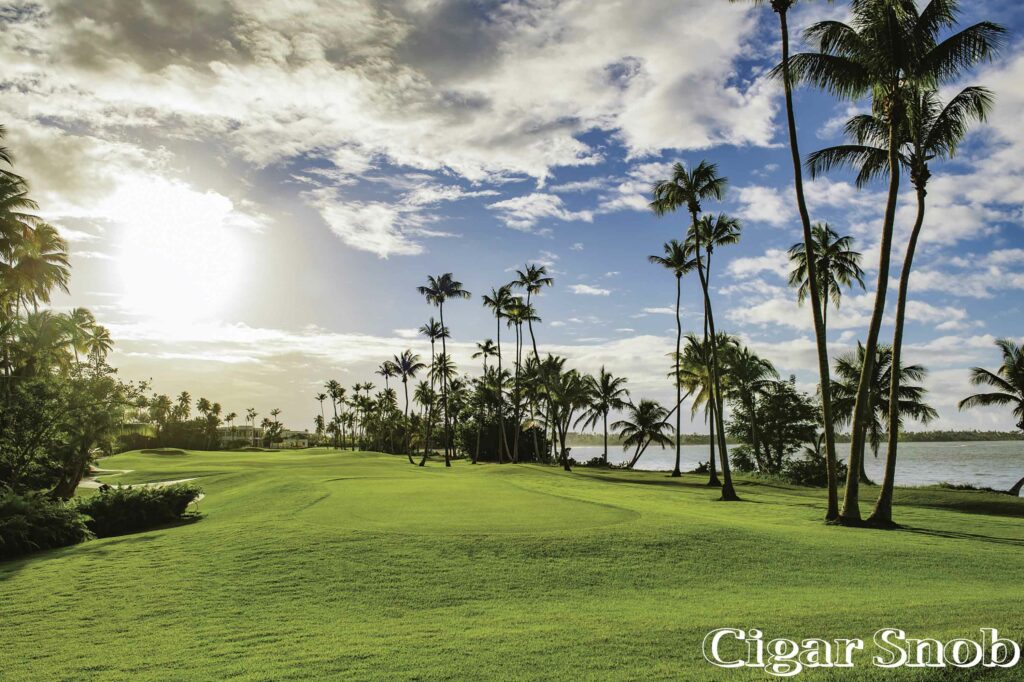
St. Regis Bahia Beach Resort and Golf Club
An ultra-luxurious, 5-star resort set amidst a lush and impeccably manicured tropical jungle. The 483-acre Audubon International Gold-certified property, with its winding rivers, ocean breezes, and looming Fernando Botero sculptures, emanates calm and relaxation throughout your stay. For food and drink, it starts with the swanky St. Regis Bar, which serves light dishes and well-executed cocktails. Seagrapes Restaurant is the workhorse of the resort, offering all-day dining and serving as the poolside eatery as well. Finally, you’ll want to dress up for dinner at Paros Restaurant, the Mediterranean themed Greek taverna-style restaurant on the resort’s grounds.
Bahia Beach shines when it comes to amenities. The Iridium Spa is widely considered one of the best on the island, the pool esplanade combines open and playful spaces with private, elegant cabanas just steps from the beach, there’s a state-of-the-art fitness center, miles of nature trails, a boathouse on the Espiritu Santo River where you can rent watercrafts, and of course, the Robert Trent Jones Jr.-designed golf course.
The tranquil and calming energy you feel in the resort also permeates your round of golf at Bahia Beach. From the tips it stretches out to 6,590 yards and every inch of it exudes luxury, attention to detail, and natural beauty. We arrived a little rushed for an early tee time, which is never optimal, but after tensely scrambling through the opening par-4, the pressure and tension subsided with every hole thereafter. Approaching the 8th green we came across a young man who took our food order to be picked up at the turn to the back nine – a wonderful and much appreciated touch.
From a golf perspective, there is much to love about this immaculately maintained Robert Trent Jones layout. There are a fair amount of water hazards and bunkers throughout, forcing you to strategize before almost every swing. Proceedings build to a crescendo starting on 16 when you climb a set of steps to an elevated tee that reveals miles of beachfront. The moment I sank the last putt on 18, I was overwhelmed with gratitude for having played this course.
Featured Holes:
The par-3 185-yard 4th hole is an early test of mettle with a uniquely isolated feel. The tall trees that run all the way along the right-hand side and the obstructed view of the #5 tee gives the sense that your group is the only one out there. The challenge is in carrying the water without going long into the bunkers that guard the back of the green. The mounds that cover the fairway give you the sense that if you bail out to the right, you may roll into the water off the mounds. RTJ forces your hand in a subtle but deliberate manner.
It’s hard not to pick the 16th as it is the signature hole and the first where the ocean joins your round, but the par-4 18th is one of the better finishing holes in the Caribbean in my estimation. The fairway is literally sandwiched between a lake along the left and the crashing waves of the ocean on the right.
At times the amount of wind ripping through the palm trees makes it feel like it is inevitable that your ball will be pushed into the lake but the fairway does widen generously in the landing area, you just can’t tell from the tee box. At 485 yards, 18 also happens to be the longest par-4 on the course and there are times when the wind is at your back providing a little more juice for your driver but making your approach harder to gauge.
More Golf
The island is teeming with excellent golf and I’d be remiss if I didn’t mention some of the island’s other top tracks starting with the TPC Dorado Beach. Courses bearing the Tournament Players Club badge need no introduction, and these two layouts live up to the billing. The East Course, a Robert Trent Jones Sr. design founded in the 1950s, was later renovated by his son, Jones Jr. And while the East Course is the “granddaddy” of Puerto Rico golf, the Sugarcane Course, also designed by Jones Sr. and updated by Raymond Floyd in 2005, is the more punishing of the two.
Both courses are an integral amenity of the posh Ritz-Carlton Reserve – Dorado Beach. The Links at Royal Isabela is unquestionably one of the more dramatic golf landscapes in all of the Caribbean. Brothers Charlie and Stanley Pasarell walked the grounds for years with designer David Pfaff to lay out a links-style track that takes full advantage of the natural features of the 426-acre site. Wyndham Grand Rio Mar Golf features a pair of 18-hole courses, the Ocean Course designed by George and Tom Fazio and the more challenging River Course by Greg Norman. In addition to the golf, the Wyndham is an all-inclusive resort with standout food options like the chef-driven Roots Coastal Kitchen.
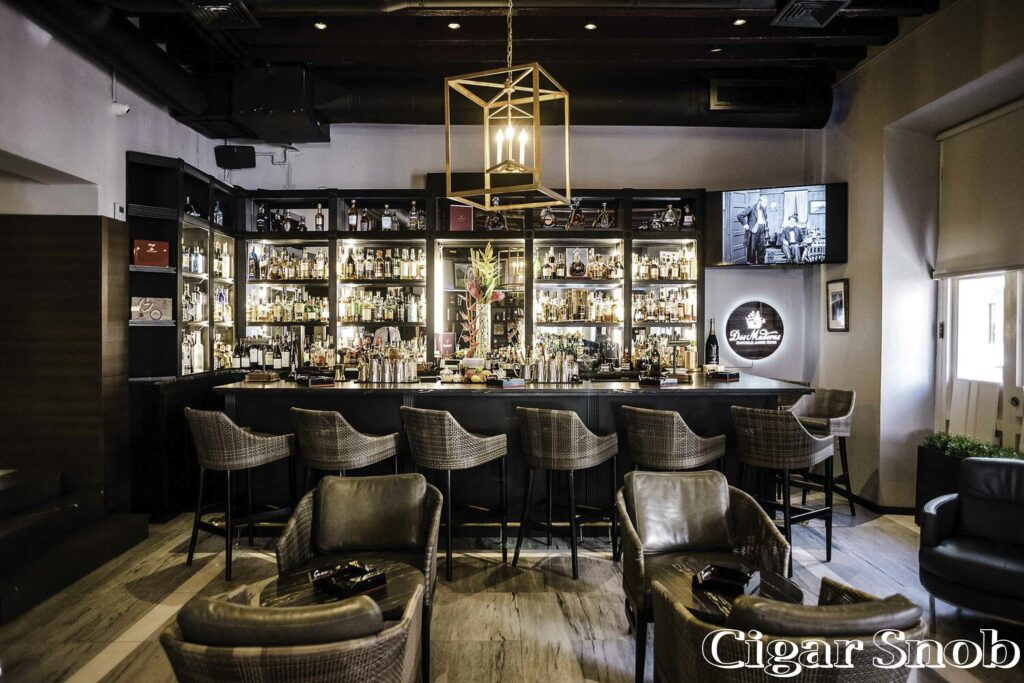
Photo: casademontecristopr.com
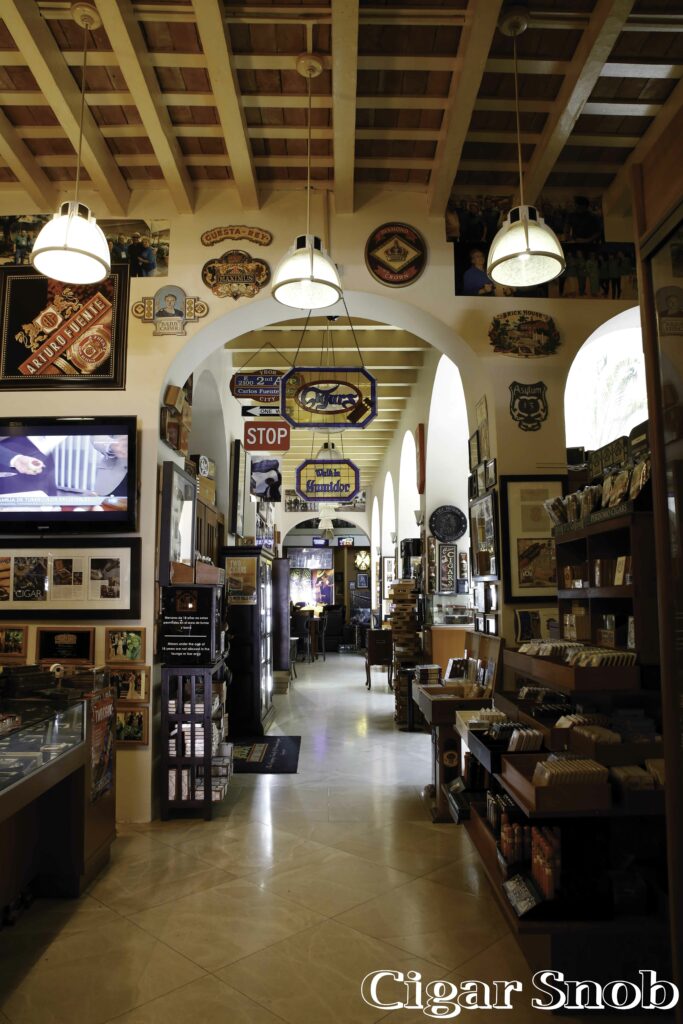
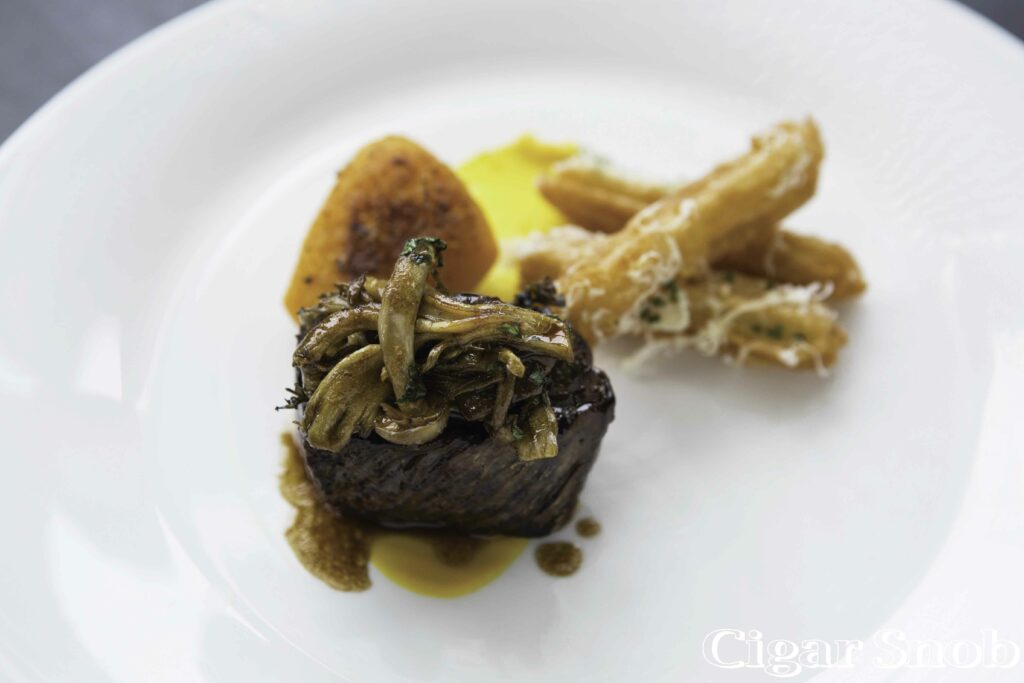
A Night in Condado
Once the golf was done, I headed back into the Condado neighborhood of San Juan, my old stomping ground. In the late 1990s I lived on Ashford Ave, Condado’s main thoroughfare, near the Condado Vanderbilt Hotel where I would be staying this evening.
Walking into the hotel feels like you’re entering a scene from the Great Gatsby, with the striking grandeur of polished marble, gold accents, and winding staircases. That’s no coincidence, as the property opened its doors in 1919, the height of the Jazz Age. That feeling of excess and luxury are noticeable everywhere, from the gilded hallways, and the spacious and well-appointed guest rooms, to the bars and restaurants.
Dinner at 1919, the hotel’s fine dining restaurant, was mind blowing. Internationally recognized chef Juan José Cuevas returned to his roots on the island to run 1919 after working under some of the world’s pre-eminent chefs. You will be hard-pressed to find a better dining experience anywhere on the island, or in your town for that matter.
After dinner the move is to visit the hotel’s Avo Cigar Lounge for a nightcap. With the discreet entrance located at the end of the Veritas Wine and Cognac Bar, the Avo Lounge has a speakeasy vibe to it. Once inside, however, you’ll find comfortable seating, a good selection of premium cigars and spirits, and a staff that can help you pull off the perfect pairing.
Cigar Scene
Outside of the Condado Vanderbilt, the cigar scene on the island is thriving once again. A comprehensive smoking ban that took effect in 2007 made it nearly impossible to enjoy a smoke on the once cigar-friendly island. I was not sure what to expect before this trip but I was pleasantly surprised to find a resurgence of cigar culture. It still has a ways to go to return to the days when every major resort catered to the affluent, cigar-smoking guest, but progress has definitely been made.
If you’re looking to enjoy a smoke in Old San Juan, you will have plenty of options like Casa de Montecristo, which is conveniently located on Calle del Cristo. “Casa” features a full bar featuring high-end whiskies, rums, and classic cocktails. The well-stocked, walk-in humidor is heavy on well-known brands like Montecristo, Davidoff, and Padrón to name a few. There is plenty of seating in the main lounge as well as in the various nooks and back rooms but on busy weekends it can be standing room only.
The Cigar House of Puerto Rico has what is likely the best cigar selection on the island; you’ll find all of the major brands like My Father, Oliva, Fuente, and La Flor Dominicana as well as many smaller, lesser-known brands including some local ones. The bar at The Cigar House has plenty to choose from with a broad range of rare spirits, wines, and even craft beer. This classic tobacconist also offers pipes and pipe tobacco, one of the only to do so in the area. This legendary spot is not to be missed on a visit to San Juan.
Spread out across six locations on the island is Don Rey Cigar. These neighborhood shops are geared more for locals but adventurous smokers looking for that neighborhood feel should look them up.
Piccolino Cigar Lounge is a welcome rarity, a cigar lounge with a full bar and excellent food service. The food comes from the Italian restaurant next door – Piccolino Cucina Italiana. The selection of smokes is solid with brands like Davidoff, Plasencia, and Romeo y Julieta among others.
Head south of San Juan to the small town of Juana Diaz and check out Juana Diaz Cigars but call before dropping in, as they aren’t open every day. If you do stop by, you will be pleased with the selection and small-town charm of this spot.
Interest in cigars is growing on the island and while I could not visit all of the interesting spots throughout Puerto Rico, I suggest you explore for yourself and let us know which ones were your favorites via [email protected].
The Island of Enchantment or Isla del Encanto comes by its name honestly. The breathtaking beauty of this place, the Boricua spirit of its people, and the island’s magic stay with you long after you’ve returned to your life back home.

